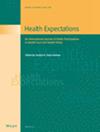‘All I Do Is Sit in a Chair Until the Pain Fades’—Experiences of Living With Gout
Abstract
Background
Living with gout impacts most dimensions of life. However, there is a lack of studies exploring the trajectory of patients' experiences of living with and being treated for gout, beyond the experiences during a flare. This study aimed to explore how individuals with gout experience the disease, its effects on daily life and their encounters with healthcare.
Methods
A constructivist grounded theory was used, involving simultaneous data collection and analysis. Semi-structured individual interviews were conducted with 12 individuals living with gout and aged between 40 and 87 in Central Sweden.
Results
Navigating the uncertainty of living with gout was represented through two categories: ‘a mismatch between individuals' needs and the provision of care’ and ‘a process of adaptation’. The mismatch involved unmet needs for pain relief, feeling dismissed as having a minor condition and a lack of personalised care. The adaptation process included seeking explanations, developing self-management strategies and adjusting to pain and functional limitations.
Conclusions
Living with gout entails a significant degree of uncertainty. The process of adaptation is affected by a mismatch between individuals' needs and the care provided, in addition to the disease's ‘roller coaster’ nature and its slow progression.
Patient and Public Contribution
This study is part of a research project aimed at gathering knowledge essential for developing an intervention in primary care. A patient, appointed by the Swedish Rheumatism Association, is actively participating in the project's research group. The results of this study have been discussed and analysed within the research group, including input from the patient participant.


 求助内容:
求助内容: 应助结果提醒方式:
应助结果提醒方式:


